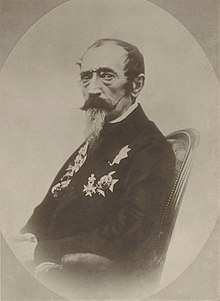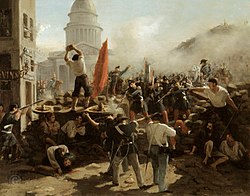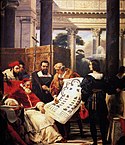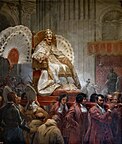Horace Vernet
Horace Vernet | |
|---|---|
 Self-Portrait with Pipe, 1835 | |
| Born | Émile Jean-Horace Vernet 30 June 1789 Paris, France |
| Died | 17 January 1863 (aged 73) Paris, France |
| Known for |
|
| Movement | Orientalist |
Émile Jean-Horace Vernet (French pronunciation: [emil ʒɑ̃ ɔʁas vɛʁnɛ]; 30 June 1789 – 17 January 1863) more commonly known as simply Horace Vernet, was a French painter of battles, portraits, and Orientalist subjects.
Biography

Early career
Vernet was born to
Restoration France



He gained recognition during the Bourbon Restoration for a series of battle paintings commissioned by the duc d'Orleans, the future King Louis-Philippe. Critics marvelled at the incredible speed with which he painted.[3] Many of his paintings made during this early phase of his career were "noted for their historical accuracy as well as their charged landscapes".[4] Examples of paintings in this style include his Four Battles series: The Battle of Jemappes (1821), The Battle of Montmirail (1822), The Battle of Hanau (1824), and The Battle of Valmy (1826). Enjoying equal favour with the court and with the opposition, he was appointed director of the French Academy in Rome, from 1829 to 1835.[1]
Over the course of his long career, Horace Vernet was honoured with dozens of important commissions.
Later career
His depictions of
Vernet also developed an interest in daguerreotype photography. He took photographs in Egypt as reference material for his paintings, and during a stop at Malta in March 1840 while en route to Egypt, he took the earliest known photographs of the island at Fort Manoel. Today these early photographs are believed to be lost.[7]
Vernet died in his hometown of Paris in 1863.
Literary references
In Arthur Conan Doyle's Sherlock Holmes story "The Adventure of the Greek Interpreter", Holmes claims to be related to Vernet, stating, "My ancestors were country squires... my grandmother... was the sister of Vernet, the French artist", without further clarifying whether this is Claude-Joseph Vernet, Carle Vernet, or Horace Vernet. The Holmes-Vernet connection is also central to the plot of Laurie R. King's 2024 novel, The Lantern's Dance.
Gallery
-
The Barrier of Clichy (1820)
-
Napoleon bids farewell to his Guard (1824)
-
Napoleon at the Battle of Arcole (1826)
-
The Battle of Valmy (1826)
-
Polish Prometheus (1831)
-
The Duke of Orleans leaving the Palais-Royal (1832)
-
Hunting in the Pontine Marshes (1833)
-
Napoleon at the Battle of Friedland (1835)
-
The Battle of Jena (1836)
-
The Capture of Constantine (1838)
-
Scene from the Mexican Expedition in 1838 (1841)
-
Judith et Holopherne (1831)
-
The Taking of the Malakoff Redoubt (1858)
-
An Algerian Lady Hawking (1829)
-
Siege of Saragossa (1819)
-
Pope Julius II ordering Bramante and Michelangelo to design St Peter's Basilica (1827)
-
Pope Pius VIII brought to the Basilica of Saint Peter in Rome (1829)
-
Plague in Barcelona (1822)
References
- ^ a b c One or more of the preceding sentences incorporates text from a publication now in the public domain: Chisholm, Hugh, ed. (1911). "Vernet s.v. Émile Jean Horace Vernet". Encyclopædia Britannica. Vol. 27 (11th ed.). Cambridge University Press. pp. 1030–1031.
- ^ "Washington and Lee University". Home.wlu.edu. Archived from the original on 2013-10-12. Retrieved 2012-06-11.
- ^ a b Ruutz-Rees, Janet E. (Janet Emily) (1880). Horace Vernet. New York: Scribner and Welford.
- ^ The Art of War[s]: Paintings of Heroes, Horrors and History – Chase Maenius
- )
- JSTOR 10.7591/j.ctt20fw60j.
- ^ Bonello, Giovanni (10 February 2019). "But who was the first Maltese photographer?". Times of Malta. Archived from the original on 30 June 2020.
Further reading
- Dayot, Armand (1898). Les Vernet : Joseph—Carle—Horace. Paris: A. Magnier.
- Harkett, Daniel and Katie Hornstein, eds, (2017). Horace Vernet and the Thresholds of Nineteenth-Century Visual Culture. Dartmouth College Press/University Press of New England.
- Ruutz-Rees, Janet E. (Janet Emily) (1880). Horace Vernet. New York: Scribner and Welford.
- Sessions, Jennifer E. (2011), By Sword and Plow: France and the Conquest of Algeria. Cornell University Press.


















